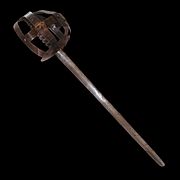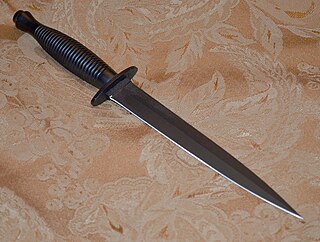
A dagger is a fighting knife with a very sharp point and usually one or two sharp edges, typically designed or capable of being used as a cutting or thrusting weapon. Daggers have been used throughout human history for close combat confrontations, and many cultures have used adorned daggers in ritual and ceremonial contexts. The distinctive shape and historic usage of the dagger have made it iconic and symbolic. A dagger in the modern sense is a weapon designed for close-proximity combat or self-defense; due to its use in historic weapon assemblages, it has associations with assassination and murders. Double-edged knives, however, play different sorts of roles in different social contexts.
A sword is an edged, bladed weapon intended for manual cutting or thrusting. Its blade, longer than a knife or dagger, is attached to a hilt and can be straight or curved. A thrusting sword tends to have a straighter blade with a pointed tip. A slashing sword is more likely to be curved and to have a sharpened cutting edge on one or both sides of the blade. Many swords are designed for both thrusting and slashing. The precise definition of a sword varies by historical epoch and geographic region.
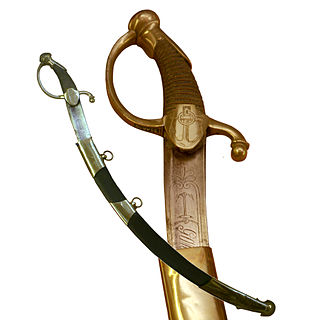
A sabre is a type of backsword with a curved blade associated with the light cavalry of the early modern and Napoleonic periods. Originally associated with Central European cavalry such as the hussars, the sabre became widespread in Western Europe during the Thirty Years' War. Lighter sabres also became popular with infantry of the early 17th century. In the 19th century, models with less curving blades became common and were also used by heavy cavalry.
A backsword is a type of sword characterised by having a single-edged blade and a hilt with a single-handed grip. It is so called because the triangular cross section gives a flat back edge opposite the cutting edge. Later examples often have a "false edge" on the back near the tip, which was in many cases sharpened to make an actual edge and facilitate thrusting attacks. From around the early 14th century, the backsword became the first type of European sword to be fitted with a knuckle guard.
This is a list of types of swords.
The yatagan, yataghan or ataghan, also called varsak, is a type of Ottoman knife or short sabre used from the mid-16th to late 19th century. The yatagan was extensively used in Ottoman Turkey and in areas under immediate Ottoman influence, such as the Balkans and the Caucasus.

Swordsmanship or sword fighting refers to the skills and techniques used in combat and training with any type of sword. The term is modern, and as such was mainly used to refer to smallsword fencing, but by extension it can also be applied to any martial art involving the use of a sword. The formation of the English word "swordsman" is parallel to the Latin word gladiator, a term for the professional fighters who fought against each other and a variety of other foes for the entertainment of spectators in the Roman Empire. The word gladiator itself comes from the Latin word gladius, which is a type of sword.

The English language terminology used in the classification of swords is imprecise and has varied widely over time. There is no historical dictionary for the universal names, classification, or terminology of swords; a sword was simply a single-edged or double-edged knife.
A dirk is a long-bladed thrusting dagger. Historically, it gained its name from the Highland dirk where it was a personal weapon of officers engaged in naval hand-to-hand combat during the Age of Sail as well as the personal sidearm of Highlanders. It was also the traditional sidearm of the Highland Clansman and later used by the officers, pipers, and drummers of Scottish Highland regiments around 1725 to 1800 and by Japanese naval officers.

The makhaira is a type of Ancient Greek bladed weapon and tool, generally a large knife or sword, similar in appearance to the modern day machete, with a single cutting edge.

A messer is a single-edged sword of the 15th and 16th century, characterised by knife-like hilt construction methods.

A pistol sword is a sword with a pistol or revolver attached, usually alongside the blade. It differs from a rifle with a bayonet attached, in that the weapon is designed primarily for use as a sword, and the firearm component is typically considered a secondary weapon designed to be an addition to the blade, rather than the sword being a secondary addition to the pistol. In addition, the two components of these weapons typically cannot be separated, unlike most bayonets mounted on rifles.
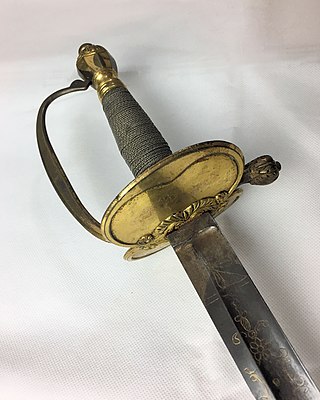
A spadroon is a light sword with a straight-edged blade, enabling both cut and thrust attacks. This English term first came into use in the early 18th century, though the type of sword it referred to was in common usage during the late 17th century. They were primarily used as a military sidearm in the late 17th and early 18th centuries, and for officers and NCOs in the latter part of the 18th and early 19th centuries. The type of sword also saw widespread use across Europe and America, though the term 'spadroon' is unique to the Anglophone world.

The bilbo is a type of 16th century, cut-and-thrust sword or small rapier formerly popular in America. They have well-tempered and flexible blades and were very popular aboard ships, where they were used similarly to a cutlass. The term comes from the Basque city of Bilbao, Bilbo in Basque, where the metal was extracted and later sent to Toledo, a city in the center of Spain, where these swords were forged and exported to the New World. These swords were also sold to merchants of every European nation, including England.
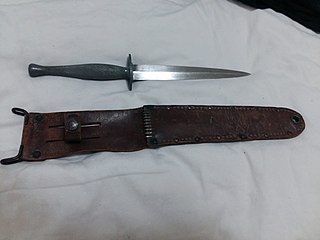
The United States Marine Raider stiletto was issued to the Marine Raiders and 1st Canadian Parachute Battalion during World War II.
A single-edged sword may refer to any single-edged bladed weapon with a hilt which is shorter than a polearm. Examples include:
Private purchase naval weapons are maritime weapons that were used aboard ships other than those in regular navies. They were stocked on private vessels for either an offensive or defensive purpose that did not fall under any actual branch of any naval department. Thus, they do not bear standard government issue marks of their host country despite their use aboard said ships of that country. These weapons were important to maritime history because they equipped privateers, pirate vessels and merchant galleys as a means of defense. They were used just as their naval cousins in both attacking and defending during hostile boarding. Private purchase boarding axes were both used as a weapon and a tool for fires aboard ship. Other than their lack of government issue markings, they served the same purpose. Private ship owners lacked the resources of nations to supply their needs, so sometimes even rough blacksmith-made items of primitive manufacture were used.
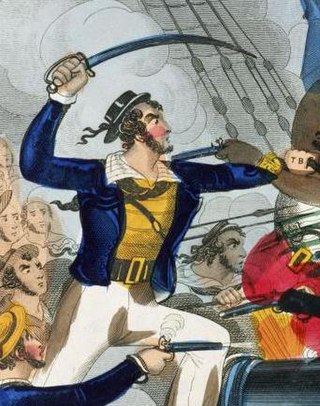
Ratings of the Royal Navy have used cutlasses, short, wide bladed swords, since the early 18th century. These were originally of non-uniform design but the 1804 Pattern, the first Navy-issue standard cutlass, was introduced at the start of the 19th century. This was a bluntish weapon that was perhaps intended for cutting away canvas and ropes rather than as a thrusting combat weapon. The 1845 Pattern cutlass introduced a bowl-style hand guard which provided greater protection, with a longer and more curved blade. Its sharper point made it more useful for thrusting attacks, which were now emphasised in the drill manual. The 1845 Pattern was modified several times including shortening and straightening the blades, which weakened them. The 1889 Pattern had a straight, spear-pointed blade with a hilt that curved outwards to catch and redirect an opponent's sword point. The 1900 Pattern, the last navy-issue cutlass, was similar to its predecessor with the introduction of a fuller and a hilt insert that cushioned the user's little finger. The cutlass was withdrawn from service in 1936 but remains in use for ceremonial purposes. It is thought that it was last used in combat in 1900 during the Boxer Rebellion.
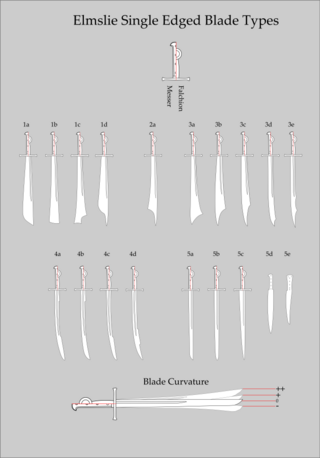
The Elmslie typology is a system for classification and description of the single edged European bladed weapons of the late medieval and early baroque period, from around 1100 to 1550. It is designed to provide classification terminology for archaeological finds of single-edged arms, as well as visual depictions in art. It includes swords which are from the Europeans Middle Ages and currently breaks them down into five main types, which each have several subtypes. Historian and bladesmith James Elmslie introduced the typology 2015, as a complement to the Oakeshott typology which covers double edged swords of the same periods.




